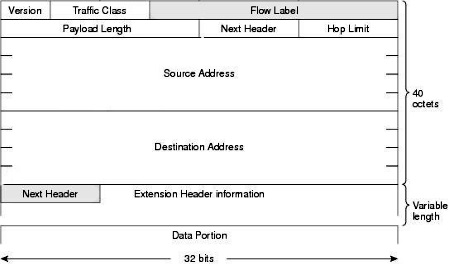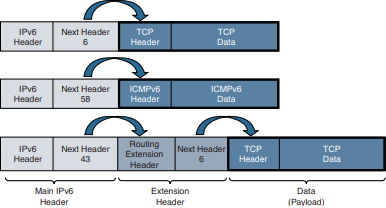IPv6 has a field, the Next Header field, that specifies the type of header expected after the main IPv6 header. Although it is similar to the IPv4 Protocol field, there is an additional option.

The initial values for various protocols are specified in RFC 1700, Assigned Numbers, and were later replaced by an online database maintained by the Internet Assigned Numbers Authority (IANA) at www.iana.org/assignments/protocol-numbers/ protocol-numbers.xml. The same values used in the IPv4 Protocol field are used in the IPv6 Next Header field, along with some additional values for IPv6. Some of the most common values for both protocols are 6 for TCP and 17 for UDP.
In a situation when there is only the main IPv6 header and no extension headers, the Next Header field specifies the protocol carried in the data portion of the IPv6 packet. This is similar to the Protocol field in the IPv4 header.
Significant IPv6 Next Header Field Values
| Next Header Field Value | Description | |
| Decimal | Hexadecimal | |
| 0 | 0 | Hop-by-hop options extension header for IPv6 |
| 1 | 1 | Internet Control Message Protocol version 4 (ICMPv4) |
| 2 | 2 | Internet Group Management Protocol version 4 (IGMPv4) |
| 4 | 4 | IPv4 encapsulation |
| 5 | 5 | Internet Stream Protocol (ST) |
| 6 | 6 | Transmission Control Protocol (TCP) |
| 8 | 8 | Exterior Gateway Protocol (EGP) |
| 17 | 11 | User Datagram Protocol (UDP) |
| 41 | 29 | IPv6 encapsulation |
| 43 | 2B | Routing extension header for IPv6 |
| 44 | 2C | Fragment header for IPv6 |
| 46 | 2E | Resource Reservation Protocol (RSVP) |
| 47 | 2F | Generic Routing Encapsulation (GRE) |
| 50 | 32 | Encapsulating Security Payload (ESP) |
| 51 | 33 | Authentication Header (AH) |
| 58 | 3A | Internet Control Message Protocol version 6 (ICMPv6) |
| 59 | 3B | No Next Header for IPv6 |
| 60 | 3C | Destinations options extension header for IPv6 |
| 88 | 58 | Enhanced Interior Gateway Routing Protocol (EIGRP) |
| 89 | 59 | Open Shortest Path First (OSPF) |

Above shows three examples of the IPv6 Next Header field in decimal, indicating the information following the main IPv6 header. Usually, the information after the main IPv6 header is the data or payload, such as a TCP segment. But as the last example above illustrates, the Next Header field can also point to an extension header.
About the Author
Rick Graziani has been an instructor of computer networking and computer science courses at Cabrillo College in Aptos, California since 1994. Rick also teaches networking courses in the Computer Engineering department at the University of California, Santa Cruz and is on the Curriculum Engineering team for Cisco Networking Academy.
Organizations are increasingly transitioning to IPv6, the next generation protocol for defining how devices of all kinds communicate over networks. Now fully updated, IPv6 Fundamentals offers a thorough, friendly, and easy-to-understand introduction to the knowledge and skills you need to deploy and operate IPv6 networks.
Leading networking instructor Rick Graziani explains all the basics simply and clearly, step-by-step, providing all the details you'll need to succeed. You'll learn why IPv6 is necessary, how it was created, how it works, and how it has become the protocol of choice in environments ranging from cloud to mobile and IoT.
Graziani thoroughly introduces IPv6 addressing, configuration options, and routing protocols, including EIGRP for IPv6, and OSPFv3 (traditional configuration and with address families). Building on this coverage, he then includes more in-depth information involving these protocols and processes.
This edition contains a completely revamped discussion of deploying IPv6 in your network, including IPv6/IPv4 integration, dynamic address allocation, and understanding IPv6 from the perspective of the network and host. You'll also find improved coverage of key topics such as Stateless Address Autoconfiguration (SLAAC), DHCPv6, and the advantages of the solicited node multicast address.
Throughout, Graziani presents command syntax for Cisco IOS, Windows, Linux, and Mac OS, as well as many examples, diagrams, configuration tips, and updated links to white papers and official RFCs for even deeper understanding.
• Learn how IPv6 supports modern networks encompassing the cloud, mobile, IoT, and gaming devices
• Compare IPv6 with IPv4 to see what has changed and what hasn't
• Understand and represent IPv6 addresses for unicast, multicast, and anycast environments
• Master all facets of dynamic IPv6 address allocation with SLAAC, stateless DHCPv6, and stateful DHCPv6
• Understand all the features of deploying IPv6 addresses in the network including temporary addresses and the privacy extension
• Improve operations by leveraging major enhancements built into ICMPv6 and ICMPv6 Neighbor Discovery Protocol
• Configure IPv6 addressing and Access Control Lists using a common topology
• Implement routing of IPv6 packets via static routing, EIGRP for IPv6, and OSPFv3
• Walk step-by-step through deploying IPv6 in existing networks, and coexisting with or transitioning from IPv4
Reader Lucas Schultz says, "If you are looking to take the CCNA and IPv6 is not clear to you after Cisco material, this is the book you. This is the best in depth discuss about IPv6 how it works and the mechanisms to make it work. Author made it very easy to read and understand. Highly recommend this book to IT personnel or CCNA certification.



